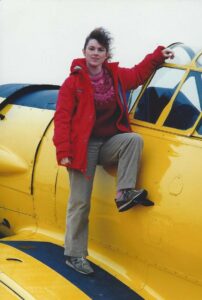Keep your eye on the leader is a lesson I learned when I flew formation.
On summer weekends in the 1990’s, I flew single-engine, ex-military aircraft at small airshows and flight demonstrations. In groups of four, we would perform a choreographed routine of fingertip, echelon, diamond, in-trail and, on memorial occasions, the missing man formations.
As the years have passed, I realize that there were many life lessons in those safe and entertaining formation flights.
Learning the basics of formation flight began with my flight mentors and friends at the Canadian Harvard Aircraft Association in Tillsonburg. Through an intensive weekend of ground instruction and flight practice a group of us pilots were introduced to a series of hand signals and safe flight techniques. At the end, if we passed the test, we earned our Wingman Patches. This course and continuous practice allowed me to fly at airshows under the guidance of a certified Leader.
A four-plane formation is made up of two flights of two aircraft. The Flight Lead is number one, their wingman is number two. Number three is second lead and their wingman is number four.
During the formation performance hand signals, passed from one pilot to another, were used to move aircraft to their next position. Before each flight our group of pilots would form up on the ground and walk through the formations, moving our bodies from one formation to another, discussing any concerns and committing the routine to memory. Even with all this practising, we were reminded to keep your eye on the leader for new instructions as the situation was always fluid.
Once in the air, we would form up in a fingertip right formation. You can get an idea of the shape of this formation by looking at the shape of your fingertips on your right hand when your fingers are held together. The lead aircraft is your middle finger. Their wingman – number two is your index finger; your ring finger is number three and your little finger is the number four aircraft.
To move from fingertip right to echelon right (a diagonal line), the lead aircraft pilot would give a one arm pump signal to number three. This told number three aircraft to drop back and down to allow number two aircraft to move over into that space between number one and three aircraft. Once number three has acknowledged the signal with a head nod, the lead aircraft gives the same single arm pump signal to the number two aircraft. Number two nods, takes a quick look to ensure the number three aircraft has made room and then slides the aircraft into that space.
This is the basis of formation flight: a signal is given, acknowledged and action is taken.
Sounds simple enough, but I have seen some things go askew.
Letting off too much throttle can put your aircraft way out of formation and it creates a whiplash effect for those that follow you, increasing the recovery needed by each pilot. Coming too close to the other aircraft can be dangerous, as you can imagine.
I remember one airshow performance when our leader decided to do dumbbell turns in the air at each end of runway rather than an oval circuit that would take us further from the audience. The dumbbell turns had us turning tightly and returning quickly to show centre. As we roared through each turn, changing formations at the same time, all of us were sweating as we tried to keep it tight and safe. The crowd thought it was a great show. To the pilots it felt like we might drop from the sky. Full throttle, full back, and full rudder, full opposite rudder, hold formation, repeat. For 10 minutes.
Lots of exhilaration and lots of practice led to a safe if tense flight.
Here are the lessons I learned in my formation flight times.
- Keep Your Eye On The Leader
- Only acknowledge instructions you understand
- Trust your team mates but double check for safety.
- Timing and a light touch are important.
- Mistakes are magnified if repeated.
- Practice and follow procedures.
- Enjoy the moments.

